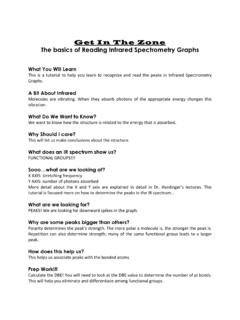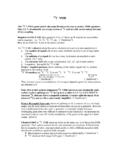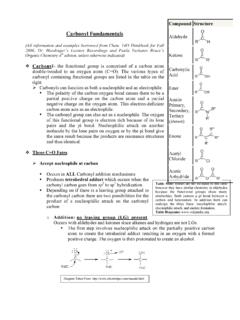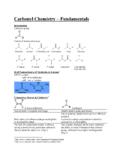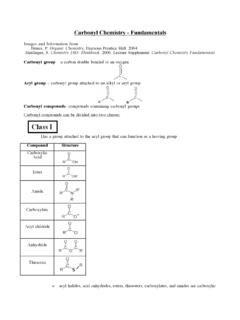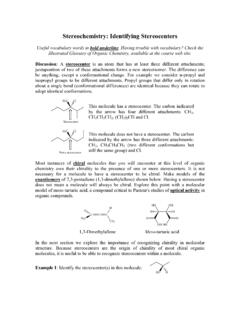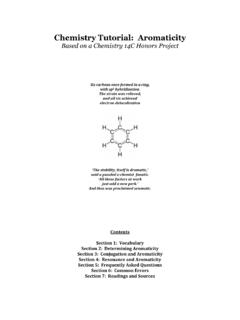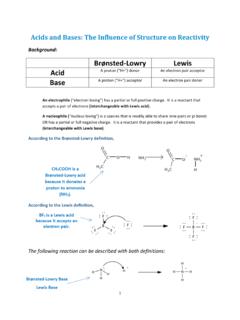Transcription of Get In The Zone The basics of Reading Infrared ...
1 Get In The Zone The basics of Reading Infrared Spectrometry Graphs What You Will Learn This is a tutorial to help you learn to recognize and read the peaks in Infrared Spectrometry Graphs. A Bit About Infrared Molecules are vibrating. When they absorb photons of the appropriate energy changes this vibration. What Do We Want to Know? We want to know how the structure is related to the energy that is absorbed. Why Should I care? This will let us make conclusions about the structure. What does an IR spectrum show us?
2 FUNCTIONAL GROUPS!!! are we looking at? X AXIS: stretching frequency Y AXIS: number of photons absorbed More detail about the X and Y axis are explained in detail in Dr. Hardinger s lectures. This tutorial is focused more on how to determine the peaks in the IR What are we looking for? PEAKS! We are looking for downward spikes in the graph . Why are some peaks bigger than others? Polarity determines the peak s strength. The more polar a molecule is, the stronger the peak is. Repetition can also determine strength; many of the same functional group leads to a larger peak.
3 How does this help us? This helps us associate peaks with the bonded atoms. Prep Work!!! Calculate the DBE! You will need to look at the DBE value to determine the number of pi bonds. This will help you eliminate and differentiate among functional groups. ZONE 1 This zone takes place between 3700 3200 cm 1 (on the x axis) [ citation (a) ] What are we looking for? Alcohols, terminal alkynes, N H stretches Tips to Note: Peaks may vary in size. Do not immediately rule out peaks because you think they are too small!
4 T h e B r e a k d o w n A l c o h o l s ( O H ) Occur around 3650 3200 cm 1 Alcohols have a very distinct strong and broad shape. When we see this sort of elongated U shape around this region, we know there is an alcohol group. It will generally look like the portion encircled in the pink oval below. [ citation (a) ] T e r m i n a l A l k y n e s ( = C - H ) Occurs around 3340 3250 cm 1 Terminal Alkynes are generally stronger and sharper in shape.
5 The peak within the pink oval below is a terminal alkyne. Be on the lookout for similar shapes in this region. [ citation (b) ] N H s t r e t c h e s Occurs around 3500 3200 cm 1 N H stretches can mean amines or amides, but it does not necessarily have to indicate either of these. These are medium in intensity, but are broader in appearance. NOTE: Be sure to look at your molecular formula to make sure a nitrogen exists in your molecule! A nitrogen is necessary for the existence of an N H stretch!
6 All three of the following are N H stretches. The first shows a primary amine, and the second shows a tertiary amine. The last image shows an N H stretch ,which is significantly smaller than in the other examples, but still counts. [ citation (b) ] [ citation (b) ] [ citation (c) ] ZONE 2 This zone takes place between 3200 2700 cm 1 (on the x axis) [ citation (a) ] What are we looking for? Sp2 carbons, sp3 carbons, aldehydes, carboxylic acid Tips to Note: Look for C H bonding in this zone!
7 We are in organic chemistry; nearly every molecule that we deal with will involve C H bonding. Use your writing utensil to map out areas and focus in on these specific areas to make sure you are Reading the graph accurately! T h e B r e a k d o w n S p 2 C a r b o n - H y d r o g e n ( C - H ) Occurs around 3100 3000 cm 1 Sp2 carbons may vary in size and shape It is important to note exactly where you see the peak! This peak will occur in a very small range, highlight it and note it down!
8 [ Professor Steven Hardinger s Thinkbook ] S p 3 C a r b o n - H y d r o g e n / A l k y l ( C - H ) Occurs around 2960 2850 cm 1 Sp3 carbons may also vary in size and shape It is important to note exactly where you see the peak! This peak will occur in a very small range, highlight it and note it down! [ Professor Steven Hardinger s Thinkbook ] A l d e h y d e ( C - H ) One peak around 2900 cm 1 and another around 2700 cm 1 Aldehydes are of medium length and have two peaks.
9 Be careful!! The first peak is often distorted by sp3 carbons and may not bee seen! Look for the second peak around 2700 cm 1. [ Professor Steven Hardinger s Lecture Supplement] The second peak is circled in pink in the image above C a r b o x y l I c A c I d ( O - H ) Occurs around 3000 2500 cm 1 We can determine a carboxylic acid by looking for a strong, broad peak. BE CAREFUL!!! A carboxylic acid has two components, there must also be a C = O in zone 4 to have a carboxylic acid!
10 !! Notice that there is an OH stretch in zone 2 and a C=O stretch in zone 4! [ citation (d) ] Here s another example [ citation (a) ] ZONE 3 This zone takes place between 2300 2000 cm 1 (on the x axis) [ citation (a) ] T h e B r e a k d o w n A l k y n e ( C C ) Around 2260 2000 cm 1 Alkynes have variable and sharp peaks, such as the peak circled in pink below. Note: Look at your DBE value! You need 2 pi bonds to form a triple bond [ citation (e) ] N i t r i l e ( C N ) One around 2260 2220 cm 1 Alkynes have variable and sharp peaks, such as the peak in the pink circle below NOTE: REMEMBER TO USE YOUR MOLECULAR FORMULA!
